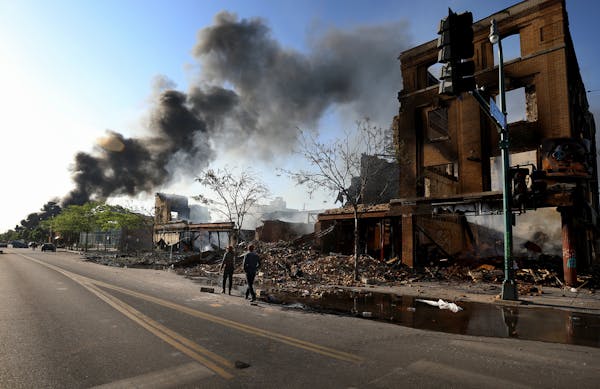Destiny Johnson stood across the street from Cup Foods in Minneapolis on Friday, facing a mural dedicated to George Floyd and other black Americans who have died at the hands of police.
And the 30-year-old evangelist had no trouble getting the crowd with her.
"This [stuff] isn't about rioting! This isn't about looting! We want what's right for our people!" she shouted, her voice rising.
Words poured out as bystanders clapped and cheered for the impromptu sermon at the shrine at 38th St. and S. Chicago Avenue where Floyd was killed Monday during an encounter with former Minneapolis police officer Derek Chauvin, who hours later was charged with murder and manslaughter.
"This goes way back! This is about 400 years of inequality!" Johnson thundered. "People asking what we want? There ain't no question about what we want!
"We want what's right! And until we get it, ain't gonna be no peace!"
The emotionally charged yet nonviolent scene was a stark contrast to the night before, when rioters drove Minneapolis police out of the Third Precinct headquarters and set the building on fire.
But both are part of the same picture, residents say: The plight of a minority community that for too long has felt oppressed and voiceless, now spurred to action by a brutal and public death.
"As a black man, I haven't come out to fight the other fights, but this is a boiling point," said Anthony Bonsante, a 29-year-old warehouse manager, facing a line of armed and armored National Guards members near the intersection of E. Lake Street and Hiawatha Avenue, where rioters inflicted heavy damage.
"We told the [Guard] captain that we are the peaceful ones, but we're still angry," Bonsante said. "This has happened so many times to us.
"These people across the city right now want blood."
Floyd's death sparked days of rioting and looting that left charred rubble and broken glass across swaths of Minneapolis and St. Paul neighborhoods, forcing Gov. Tim Walz to call in the National Guard.
Thousands participated in both peaceful demonstrations and violent protests. Taking place in an era of fully mature social media, the Twin Cities riots shifted and reacted to events in real time, much as a forest fire spreads by the sparks it throws off.
Demonstrators in one spot would get word of activity elsewhere, and suddenly people were racing to their cars and heading for the latest front line. Scenes that played out nearly in real time on Twitter and Facebook — such as a Minneapolis police officer spraying pepper gas at a group of demonstrators — incited anger and further fueled the crowds' emotions.
There were indications that agitators from outside the black community were involved in escalating the violent protests. One widely shared video showed a white man, dressed in black, wearing a full-face gas mask and carrying a black umbrella and a hammer. He calmly walked the length of the Auto Zone store on E. Lake St., methodically smashing windows with the hammer as he went.
The store was later burned to the ground.
A Star Tribune staff member encountered a group of men at the Arby's restaurant near the Third Precinct, as they prepared to loot and burn it. That building, too, was burned to the ground.
"The people that were out there at 3 o'clock in the morning weren't the great people of Minnesota," said John Harrington, commissioner of the Minnesota Department of Public Safety. They were, he said, "the arsonists, the thieves, the burglars, the vandals who were tearing apart the city of Minneapolis."
As people gathered at the protest sites Friday, some seemed drawn to the spectacle more than anything else. One man at the Hiawatha-Lake intersection held a two-liter bottle of whiskey, occasionally taking a swig from the half-empty bottle.
Others were upset by the destruction.
"I was raised on East Lake Street. The fact that this place is on fire, that the police and the National Guard are here, is absolutely breaking my heart," said Lee Younger, 18, who lives nearby and just graduated from Henry Sibley High School in Mendota Heights.
"I get why people are angry, absolutely," Younger said. "You stepped on a black person's neck, we're ready to push back." But violent protest "is not getting us anywhere. No talking is getting done, nothing's happening. We're proving to the white man that we can't do nothing without a leash.
"Our community is about art, beauty," he said. "It's about love. That's what the black community is about."
"Everything needs to stop," said Mika Williams, 31, who lives near the heavily damaged Hiawatha-Lake intersection. "Stop everything. Get our community back together."
Still, for many, anger bubbled just beneath the surface.
"I lived in Florida, where they don't give a black man a chance!" one Minneapolis man outside of Cup Foods said heatedly. "You come north where you think you have a chance. Why is Minnesota killing us?" he exclaimed before turning and quickly walking away without giving his name.

Want to share info with the Star Tribune? How to do it securely

'Safe recovery sites' would offer syringes, naloxone and more to people using drugs. The plan could be in peril.
New Minnesota GOP leaders seek peace with party's anti-establishment wing

Who is Republican Lisa Demuth, Minnesota's first House speaker of color?

